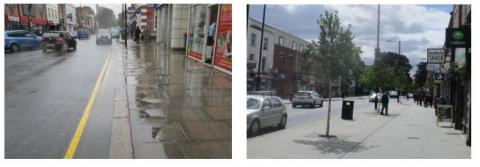Pavement and road repair treatment types
Skip to:
As part of our investment programme, we undertake 4 main types of work:
- pavement relay
- pavement patching
- road resurfacing
- road patching
The material we use for repairs is dependent on the location and type of work.
Treatment type were agreed by the Environment Committee on the 15 March 2017 (item no.13)
Pavement relay
Residential streets - type 3 material
Type 3 treatment is a mixture of a flexible asphalt footway behind a grey block margin by the kerb line.
This treatment is more flexible to withstand vehicle run over and movement caused by tree routes. This means that it maintains a smoother surface which is safer for residents rather than paving slabs that are more susceptible to cracking and causing trip hazards.
It is illegal to drive onto or over pavements if there is not a designated cross over/dropped kerb. For residents wanting to build a crossover outside their property, please visit the vehicle crossover web page.
Conservation areas and town centres - type 1 material
In town centres, it is important for us to use materials and paving slabs that are in keeping with the area, usually type 1 treatment.
In conservation areas, if we feel that an alternative treatment type to the paving slabs is most beneficial, we will consult with local ward councillors prior to any works starting.
Pavement patching
This is remedial repair to the footway surface and subbase where the footway condition has deteriorated over shorter lengths of the network that warrant remedial treatment. This treatment will be using “like for like” materials.
Road resurfacing
This treatment is used for roads that are in a state of more severe deterioration and require a full replacement. It involved a complete renewal of the surface.
Resurfacing requires taking off the existing surface of the road before a bitumen layer is laid, followed by a new surface. The depth of the area being treated is dependent on the condition of the road and could comprise several layers of material.
Typical life expectancy of the new treatment is 15-20 years.
Below is a before-and-after example of resurfacing treatment carried out to Hendon Wood Lane EN5.
Road patching
This is the remedial patching of the road's surface layer in sections, using machine laid asphalt, to a typical treatment depth of up to 40mm.



